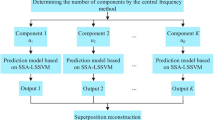Abstract
In order to better predict city daily water consumption to achieve the optimal scheduling of city water supply system, based on the research progress summarizing the city daily water consumption forecasting at home and abroad, we take the predicted daily water consumption main influence factors and predicted daily related water use after noise reduction as input, and the predicted daily water consumption after noise reduction as output. In addition, we adopt the multiple scale chaos genetic with strong global search capability and faster search speed to optimize the parameters of least square support vector machine. Moreover, we establish a prediction model of daily water consumption of least squares support vector machine based on wavelet multiple scale chaos genetic. The case analysis results show that the model proposed in this paper has strong prediction ability, compared with the least square support vector machine prediction model based on multiple scale chaos genetic, least square support vector machine prediction model based on wavelet, and prediction model based on genetic least square support vector machine algorithm. At last, it is concluded that the improved least square support vector machine has good performance in the application in daily water consumption prediction.







Similar content being viewed by others
References
Pham, B. T., Bui, D. T., Dholakia, M. B., Prakash, I., & Pham, H. V. (2016). A comparative study of least square support vector machines and multiclass alternating decision trees for spatial prediction of rainfall-induced landslides in a tropical cyclones area. Geotechnical and Geological Engineering, 34(6), 1807–1824.
Kisi, O., & Parmar, K. S. (2016). Application of least square support vector machine and multivariate adaptive regression spline models in long term prediction of river water pollution. Journal of Hydrology, 534, 104–112.
Pani, A. K., & Mohanta, H. K. (2015). Online monitoring and control of particle size in the grinding process using least square support vector regression and resilient back propagation neural network. ISA Transactions, 56, 206–221.
Mandal, S., Mahapatra, S. S., Adhikari, S., & Patel, R. K. (2015). Modeling of arsenic (iii) removal by evolutionary genetic programming and least square support vector machine models. Environmental Processes, 2(1), 145–172.
Korkmaz, S. A., & Poyraz, M. (2015). Least square support vector machine and minimum redundancy maximum relevance for diagnosis of breast cancer from breast microscopic images. Procedia - Social and Behavioral Sciences, 174(3), 4026–4031.
Liu, F., & Zhou, Z. (2015). A new data classification method based on chaotic particle swarm optimization and least square-support vector machine. Chemometrics and Intelligent Laboratory Systems, 147(15), 147–156.
Deo, R. C., Kisi, O., & Singh, V. P. (2017). Drought forecasting in eastern australia using multivariate adaptive regression spline, least square support vector machine and M5Tree model. Atmospheric Research, 184, 149–175.
Ahmadi, M. A., & Pournik, M. (2016). A predictive model of chemical flooding for enhanced oil recovery purposes: Application of least square support vector machine. Petroleum, 2(2), 177–182.
Zhang, Y., Huang, J., & Xu, K. (2015). Indoor positioning algorithm for WLAN based on principal component analysis and least square support vector regression. Yi Qi Yi Biao Xue Bao/Chinese Journal of Scientific Instrument, 36(2), 408–414.
Xu, T., Yin, Z., Cai, D., & Zheng, D. (2017). Fault diagnosis for rotating machinery based on local mean decomposition morphology filtering and least square support vector machine. Journal of Intelligent & Fuzzy Systems, 32(3), 2061–2070.
Ghiasi, R., Torkzadeh, P., & Noori, M. (2016). A machine-learning approach for structural damage detection using least square support vector machine based on a new combinational kernel function. Structural Health Monitoring, 15(3), 302–316.
Zhong, R., Xu, Y., Cao, Y., Guo, X., Hua, W., Xu, S., et al. (2016). Accurate model of switched reluctance motor based on indirect measurement method and least square support vector machine. IET Electric Power Applications, 10(9), 916–922.
Acknowledgements
The authors acknowledge the National Natural Science Foundation of China (Grant No. 61662045).
Funding
Funding was provided by National Natural Science Foundation of China (Grant No. 61662045) and the Science & Technology Foundation for Selected overseas Chinese scholar of Tianjin 2017.
Author information
Authors and Affiliations
Corresponding author
Rights and permissions
About this article
Cite this article
Zhang, W., Yang, Q., Kumar, M. et al. Application of Improved Least Squares Support Vector Machine in the Forecast of Daily Water Consumption. Wireless Pers Commun 102, 3589–3602 (2018). https://doi.org/10.1007/s11277-018-5393-2
Published:
Issue Date:
DOI: https://doi.org/10.1007/s11277-018-5393-2




